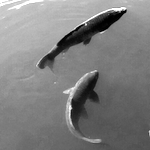Multimodality—that is, the ability to locomote across and through multiple media (land, air, or water)—is common among organisms. At least two of the three modes (swimming and flight) are achieved via the manipulation of fluids, where the aero- and hydrodynamic interactions produced by moving bodies and appendages enable remarkable feats. Among the most remarkable of these is the ability to transition quickly and efficiently between locomotor modes. This task is among the most difficult for human-designed systems to achieve, but occurs frequently and easily among many organisms. Here, we present preliminary results of an investigation into three families of freshwater insects (diving beetles, water boatmen, and backswimmers), which are notable for their ability to execute all three “main” locomotor modes (walking, swimming, and flying) within the same life stage. We examine the kinematics of free swimming, finding a “hop-and-stop” pattern driven by the interplay of viscous and inertial forces for animals swimming at intermediate Reynolds number. We compare dry-land walking gaits across the three genera, finding key differences between beetles (Coleoptera) vs. backswimmers and boatmen (Nepomorpha). Lastly, we investigate the kinematics of the water-to-air transition, which is driven by a complex interplay of surface tension and highly unsteady aero- and hydrodynamic forces.

 PDF version
PDF version
